Personal Protector 2013
![]() Written by Tomas Meskauskas on (updated)
Written by Tomas Meskauskas on (updated)
What is Personal Protector 2013?
Personal Protector 2013 should not be mistaken for legitimate antivirus software, it is a scam developed by cyber criminals to scare PC users into believing that their computers are infiltrated with high-risk malware and virus infections.
To achieve this deceptive goal, Personal Protector 2013 displays fake security scans and generates long lists of supposedly-detected security issues. In fact, it is an empty software shell, comprising neither a virus definition database nor a virus scan engine.
The processes displayed by this bogus software are merely imitated. Do not trust any information displayed by Personal Protector 2013, since its main goal is to sell a useless 'full version', which supposedly eliminates 'detected' security threats on your PC.

In fact, your computer is highly unlikely to be infected with the malware or Trojans reported by this rogue security scanner. Computer users should not be impressed by the professional appearance of this program - it is a scam intended to deceive you and steal your money.
If you do purchase the 'full version' of Personal Protector 2013, you will lose your money and your computer will remain infected. Commonly, infiltration by Personal Protector 2013 is a consequence of poor computer security. To avoid fake antivirus programs from infiltrating your PC, always use legitimate antivirus and antispware programs.
If you observe Personal Protector 2013 scanning your computer for security infections, your PC is infected with a fake antivirus program and it should be eliminated from your PC immediately.
Personal Protector 2013 is distributed by cyber criminals using drive-by downloads, Trojans, and malicious websites to proliferate their fake antivirus program. Computer users should express caution when downloading software updates and video codecs, since cyber criminals use fake updates and infected video codecs in order to infiltrate users' computers.
Under no circumstances pay for the 'full version' of Personal Protector 2013. If you have already done so, contact your credit card company and dispute the charges, explaining that you have been tricked into buying a fake antivirus program. To remove this fake security scanner from your computer, use the removal guide provided.
Instant automatic malware removal:
Manual threat removal might be a lengthy and complicated process that requires advanced IT skills. Combo Cleaner is a professional automatic malware removal tool that is recommended to get rid of malware. Download it by clicking the button below:
▼ DOWNLOAD Combo Cleaner
By downloading any software listed on this website you agree to our Privacy Policy and Terms of Use. To use full-featured product, you have to purchase a license for Combo Cleaner. 7 days free trial available. Combo Cleaner is owned and operated by Rcs Lt, the parent company of PCRisk.com read more.
Quick menu:
- What is Personal Protector 2013?
- STEP 1. Remove Personal Protector 2013 using a software.
- STEP 2. Remove using Safe Mode with Networking.
Personal Protector 2013 removal:
If you cannot download or run the spyware remover, try running the registry fix (link below). It enables execution of programs. Download the registryfix.reg file, double click it, click YES, and then OK.
Manual Personal Protector 2013 removal instructions:
Step 1
Start your computer in Safe Mode. Click Start, click Shut Down, click Restart, click OK. During your computer starting process press the F8 key on your keyboard multiple times until you see the Windows Advanced Option menu, then select Safe Mode with Networking from the list.
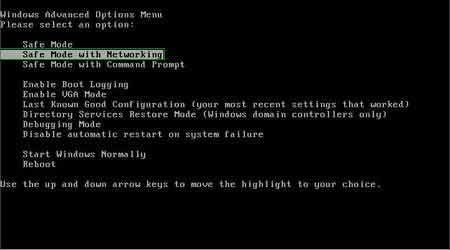
Video showing how to start Windows 7 in "Safe Mode with Networking":
Step 2
We now need to remove the proxy settings. This fake antivirus program adds a proxy to your Internet connection settings to display various errors when you attempt to access the Internet. Open Internet Explorer, click Tools, and select Internet Options. Then select the 'Connections' tab.
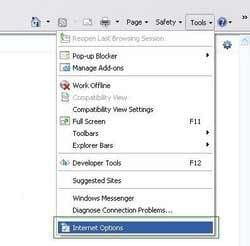
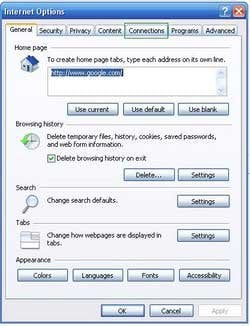
In the 'Connections' tab, click LAN settings. If 'Use a proxy server for your LAN' is checked, uncheck it and press OK.
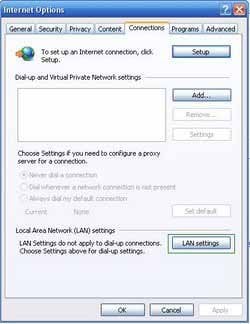
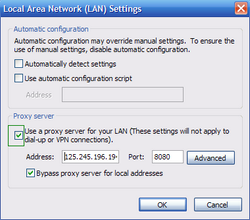
Step 3
Download HijackThis and save it to your desktop. Some malicious programs are able to block HijackThis, so when you click the download link, in the Save dialog, rename HijackThis.exe to iexplore.exe and only then click the Save button. After saving the file to your desktop, double click it.
In the main HijackThis window click the “Do a system scan only” button. Select the following entry (place a tick at the left of the entry):
O4 - HKLM\..\Run: [personalprotector] C:\Program Files\Personal Protector\personalprotector.exe
After selecting the required entry, click "Fix Checked". After this procedure you can close HijackThis and proceed to the next removal step.
Step 4
Download legitimate anti-spyware software to fully remove Personal Protector 2013 from your computer.
Step 5
After removing Personal Protector 2013, you will need to reset your Hosts file. Do not skip this step, since this malware modifies your Hosts file, and you will encounter browser redirect problems if malicious entries are not removed from it.
The Hosts file is used to resolve canonical names of websites to IP addresses. When it is changed, the user may be redirected to malicious sites, despite seeing legitimate URLs in address bar. It is difficult to determine sites are genuine when the Hosts file is modified.
To fix this, please download the Microsoft Fix It tool, that restores your Hosts file to the Windows default. Run this tool when downloaded and follow the on-screen instructions. Download link below:
After completing these steps, your computer should be clean.
Other tools known to remove Personal Protector 2013:
Summary:
The fake antivirus programs (also known as "rogue antivirus programs" or "scareware") are applications that tries to lure computer users into paying for their non-existent full versions to remove the supposedly detected security infections (although the computer is actually clean). These bogus programs are created by cyber criminals who design them to look as legitimate antivirus software. Most commonly rogue antivirus programs infiltrate user's computer using poop-up windows or alerts which appear when users surf the Internet. These deceptive messages trick users into downloading a rogue antivirus program on their computers. Other known tactics used to spread scareware include exploit kits, infected email messages, online ad networks, drive-by downloads, or even direct calls to user's offering free support.
A computer that is infected with a fake antivirus program might also have other malware installed on it as rogue antivirus programs often are bundled with Trojans and exploit kits. Noteworthy that additional malware that infiltrates user's operating system remains on victim's computer regardless of whether a payment for a non-existent full version of a fake antivirus program is made. Here are some examples of fake security warning messages that are used in fake antivirus distribution:

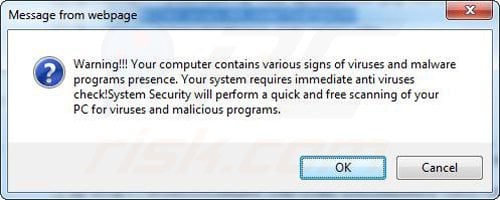
Computer users who are dealing with a rogue security software shouldn't buy it's full version. By paying for a license key of a fake antivirus program users would send their money and banking information to cyber criminals. Users who have already entered their credit card number (or other sensitive information) when asked by such bogus software should inform their credit card company that they have been tricked into buying a rogue security software. Screenshot of a web page used to lure computer users into paying for a non-existent full version of personal protector 2013 rogue and other rogue antivirus programs:
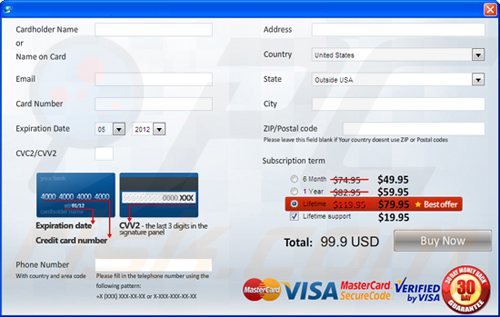
To protect your computer from personal protector 2013 rogue and other rogue antivirus programs users should:
- Keep their operating system and all of the installed programs up-to-date.
- Use legitimate antivirus and anti-spyware programs.
- Use caution when clicking on links in social networking websites and email messages.
- Don't trust online pop-up messages which state that your computer is infected and offers you to download security software.
Symptoms indicating that your operating system is infected with a fake antivirus program:
- Intrusive security warning pop-up messages.
- Alerts asking to upgrade to a paid version of a program to remove the supposedly detected malware.
- Slow computer performance.
- Disabled Windows updates.
- Blocked Task Manager.
- Blocked Internet browsers or inability to visit legitimate antivirus vendor websites.
If you have additional information on personal protector 2013 rogue or it's removal please share your knowledge in the comments section below.


▼ Show Discussion